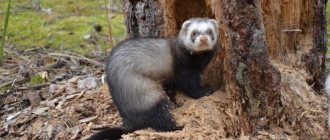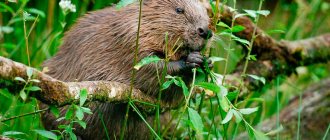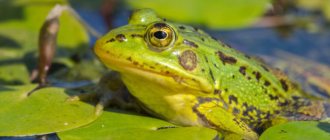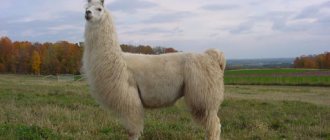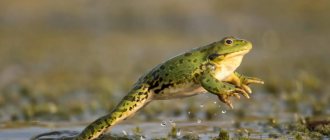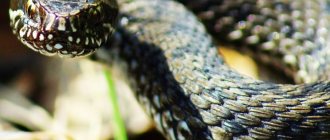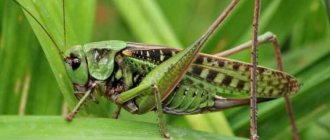The badger is an animal of the mustelidae family. These animals are distinguished by their interesting character and unusual way of life.
Today, their population has been significantly reduced by hunters, since badger fat is a valuable product and is expensive. Badgers are listed in the Red Book.
Dimensions and weight of a badger. What does the beast eat?
The badger is a small animal. The animal can reach 80-90 centimeters in length. Tail length is 15-20 centimeters.
A badger weighs on average 10-12 kg. Before wintering, the animal can weigh 30 kg.
The badger's diet is quite varied; it eats both plant foods and small animals, frogs, and insects. Here's what a badger eats:
- voles;
- small birds;
- frogs;
- insects and their larvae;
- earthworm;
- roots;
- oats and corn;
- nuts and berries.
Habits and color
The badger is a leisurely animal. He moves slowly, pressing his head to the ground. When an animal is frightened, it noticeably accelerates and moves in jumps. The animal's sense of smell is best developed. The badger's hearing and vision are not so developed.
The badger is easy to identify by its white head and two black stripes running from the ears through the eyes.
The badger has very beautiful fur. Hunters most often wonder how to find a badger hole. As a rule, not at all because of his fur. The fur of this animal is of no value, unlike badger fat, which is credited with medicinal properties.
There is no fur on the badger's belly. Sparse hairs grow there. The badger's tail is very fluffy both in winter and at other times of the year.
The badger is a beautiful animal. The sides and back of the animal are distinguished by a silvery tint. In summer, the animal's fur becomes much coarser, and brown spots appear on it.
Description
The badger is one of the largest representatives of the mustelid family: the body length is usually more than a meter, the height at the withers is up to 60 cm. It has a rather massive, squat body, covered with thick silver-grayish hair on the back, tapering towards the shoulders. The animal has short, strong legs. The claws on the forelimbs are larger and longer than those on the hind limbs. A narrow, long white muzzle with two distinctive black stripes running from the nose to the ear, catching the eyes. His small white ears are round in shape. The badger has a rather bushy tail.
The color of the fur on the back and tail is silver-gray with black ripples. The fur on the throat, neck, chest, and legs is black, and on the belly it is black and brown. Summer fur is coarser and thinner in summer. By winter, molting ends and the fur is renewed.
Before hibernating, the animal weighs about 25 kg, and immediately after waking up - 15 kg.
Features of the animal
Badgers are monogamous animals and live with one partner for many years. A female animal gives birth to 2 to 6 badgers.
Mating can occur in spring, summer and autumn.
A month after birth, the cubs already open their eyes, at the same time their teeth erupt.
The badger is a very neat animal. Perfect order always reigns in the animal's home. The animal carefully cleans its home, especially after wintering.
Where does the beast live?
Badgers live on ½ of the territory of Russia. This is a very common animal, inhabiting both forests, fields, steppes, and mountains. But the badger cannot be found in the north of the country. So, it is not found in the northern part of Siberia and in the tundra.
The following subspecies of badger are distinguished:
- Siberian.
- European, or Central Russian.
- Kazakhstani.
- Pricaspian.
- Amursky.
This animal leads a semi-underground lifestyle. Connected with this is the badger’s need to dig shelters for itself, called burrows. Any badger lives in a hole that he dug himself. These animals dig shelters on their own. Often their work is used by animals such as foxes and raccoon dogs. A wolf can occupy someone else's hole.
If the animal lives in central Russia, then it chooses ravines, forest edges and copses for living. Living in a dense coniferous forest, the badger chooses the outskirts for permanent residence.
The badger prefers to dig holes close to water. This animal chooses a place for its shelter in such a way that it is easy to get to it undetected. If there is a lot of food in the habitat, animals can organize shelters very close to each other. Most often, the badger digs holes in sandy or dry soil. The underground passage is often located on the slopes of river routes or ravines.
Hunting with a Jagdterrier
Adults are distinguished by the fact that they love peace and care only about themselves. Therefore, they mostly live alone, without their “other half”. This is precisely the reason that no more than one trophy is obtained from each hole.
Today, badger hunting with a Jagdterrier is very common. It is usually carried out with two poisoned dogs. For this type of hunting, you need to know exactly the places where badger holes are located. After they have been examined, the collars are removed from the dogs and they are allowed into the underground passages. Jagdterriers are excellent at attacking badgers; they are fearless and decisive.
Features of a badger hole
The hole of this animal, similar to a real labyrinth, has a number of features:
- she has several exits;
- it is constantly expanding;
- it is used for living by several generations of badgers.
A very old badger hole is called a “fortification”.
Badger grounds can be very branched, and they go deep to a fairly large distance from the surface.
The exit from the hole looks like an arch, which can reach a length of up to 10 meters. The nest, or nesting chamber as it is called, is located at least one meter below the surface of the earth. In the nest, the badger places a bedding of grass and leaves.
The animal sets up burrows in late summer and early autumn.
Where and how to find a badger hole? It seems easier to do this during the day, but after sunset there is a chance to hear the animal. The animal is predominantly nocturnal. You can see a badger leaving its premises during the day only in remote places. In most places, the animal leaves the hole immediately after dusk. To determine the location of the hole, it is enough to wait until the badger starts making noise.
Hunting season
It is impossible to hunt a badger all year round. It has one specific feature - a fairly long hibernation. That is why the hunting season for it is quite limited.
As a rule, it begins in late September or early October, when the animal has already gained enough subcutaneous fat - which is one of the main reasons why badger hunting is so widespread. It ends with the onset of the first cold weather, when the animal goes into hibernation.
Badger hole: how to look?
The existence of the animal is closely connected with the underground passage it dug. Most often, a badger's hole, a photo of which you can see in the article, is occupied by the owner. It is a permanent home for the animal. For several months of the year the badger does not leave the course at all.
The animal stops leaving its home in early autumn. Before falling into winter sleep, the badger closes all exits with earth, grass and leaves. This animal does not hibernate. Its body temperature decreases slightly during wintering. In the north of the country, the badger stays in its hole in winter from October to May. When a thaw occurs, the animal may leave the home.
Spring for the animal begins with cleaning and cleaning the underground passage. Later, the animal prepares for the birth of its offspring.
It has already been noted that it is easiest to spot a badger at night. At dusk it makes quite a lot of noise, since it does not hide at all.
Signs of a badger living in a particular territory are:
- the presence of well-trodden paths - along them you can find a hole;
- the holes that badgers make when looking for food;
- traces that are easy to detect and difficult to confuse with any others.
Where and how to find a badger's hole by following its tracks? It is enough to inspect smooth, moist soil. The animal's track is very similar to a bear's, but differs in size: a badger's track is much smaller than a bear's.
General information
Those who know what badger hunting is also know how tasty its meat is. And its subcutaneous fat has a number of medicinal properties. Maybe that’s why badger hunting has been popular for a long time.
Being a typical burrower, this animal spends most of its life underground, in passages dug by itself, sometimes occupying the “apartments” of a marmot. The badger mainly leads a sedentary existence. It builds its burrows in dry areas, in well-drained soil, on the southern and western slopes of ravines, hills and gullies, on high banks of rivers or lakes. All of them are necessarily located near water.
When is the best time to look for a badger hole?
The best time to search for an animal's home is early spring. At this time, the badger is cleaning his house and throwing out old grass from the hole, which was used to plug the exits. He also gets rid of the litter. Leaves, grass and earthen piles created by the animal while cleaning the hole are clearly visible even from afar.
It is best to look for a hole in places with high humidity. Answering the question of how to find a badger's hole in spring or late winter, we can say: it is enough to find the animal's paths, which the badger tramples for a very long time. Such paths stand out very well in the area. Traces of badger cleaning are also quite characteristic.
Habitats
The badger is an animal that is widespread throughout Europe. Numerous populations of the animal are observed in Russia. In domestic spaces, the animal is found almost everywhere beyond the Ural Mountains, in addition to the far north and areas with arid terrain. Badgers also live in Korea and China, and on some islands of Japan.
The animal prefers to settle in dense mixed forests. Badgers are rarely seen in steppe regions. The animals live mainly in places where there is an abundance of bushes and tall grasses, and the soil is never flooded by surface waters.
Where to look for “town” and “temporary housing”
Badgers have two types of burrows: permanent and temporary.
A dog can be very helpful in finding a temporary hole. Such passages are located shallow, and almost any dog familiar with hunting can sense the smell of a badger.
- Important! When searching for badger grounds, a “burrowing” dog must be kept on a leash!
A small dog cannot win a fight with a badger. Moreover, she will not be able to get him out of her own home. A meeting between a small dog and this animal can end very badly.
The main badger hole, that is, the “town,” is easier to find than a temporary shelter. One of the proven ways to find a badger hole in the forest is to find the animal’s toilet. The badger is careful in everything, including this issue. The animal's toilet is almost always located near the entrance to its permanent home. It is enough to thoroughly examine the area around the restroom: most likely, a hole will be found somewhere nearby.
But how to find a badger hole if there is a toilet, but the hole itself is nowhere nearby? In this case, somewhere nearby there is a temporary hole of the beast. You should move in zigzags from the animal’s toilet to possible feeding areas.
In addition, the digs of this animal are difficult to confuse with something else. This is great for finding shelter.
We must not forget that a badger can move between “temporary buildings”. It happens that the animal is busy cleaning the “town” and spends the night in a temporary hole.
If a badger leaves the “town” for any reason, young animals can take over. The permanent dwellings of the beast are passed down from generation to generation.
Trap method
Badger hunting with traps is the most effective. This is explained by the fact that badger settlements are known to experienced hunters; they have been inhabited for many years. Careful land owners always try to preserve both the burrow and the animal population in it. A burrowing dog is a luxury not available to everyone, especially rural residents. Owners of huskies prefer to hunt other animals. And an experienced trapper always has a catch by the end of autumn. This is already a trade for the sake of valuable badger fat, meat and strong skin.
The trap should be masked using improvised means that are located right there. Wide leaves, thin grass. It is possible to use clean colored napkins. Any covering, especially napkins, is additionally masked with powder. Many people use meat and bone meal as an effective powder, which additionally masks the smell. You can use dry soil mixed with badger excrement. Because traps are set on trails, it is often necessary to remove some of the soil from under the implement to level it with the trail level. In this case, the earth should not be thrown right there, it should be taken to the side. Many experts advise using bait - a piece of meat. But it rather serves a distracting function than a traditional trapping bait.
Two types of traps are applicable - arc traps for capturing the limbs of an animal and pass-through pressure type traps, which are designed for capturing by the head or across the body. The arc trap can be used with both a plate-type and a sim-type trap. Considering the small area of the animal's paw, simulator alertness is more effective. Hunting with walk-through traps is much more effective, but the process of installation and camouflage is much more complicated. In addition, the modern trend towards the humanization of hunting requires replacing barbaric methods of capturing animals. Let's leave this to the conscience of the Green Party. The badger's foot is small in size, and the strong, muscular legs do not have pronounced thickening at the joints. This circumstance sometimes helps the animal free the limb from its grip. This will not happen with the use of a walk-through trap.
The difficulty in installing such traps lies in choosing a location. This can be either a passage in the bush or a path in thickets of thick grass. The trap is a kind of gate. It is installed vertically, securing the springs with small pegs. The rope of the trap is attached to the trap and is also camouflaged. The alert itself is a SIM version, but it no longer works on the animal’s foot, but on the animal’s head. The trap grabs the badger by the neck with a sharp blow, which is much more effective and more humane.
Who is looking for holes and why?
The homes of these animals are sought by both ordinary hunters and, alas, poachers. Badger is most often harvested for its fat, which is believed to have medicinal properties. The skin of the animal, as already noted, is of little value, and there is no need to hunt a badger for its meat: it is rather tasteless and has a specific smell.
- Attention! No sane hunter would tell a stranger how to find a badger hole. Unfortunately, there are quite a lot of poachers, and it costs them nothing to barbarically destroy a settlement.
Thus, badgers live almost everywhere in Russia. And finding an animal’s hole with the proper desire is not so difficult.
Habitats
Its habitat covers almost all of Europe. Beyond the Ural Mountains, the animal can be found throughout almost the entire territory of Russia (except for the extreme northern and arid regions). Also common in China, the Korean Peninsula and Japan.
Thus, according to their habitat, the following varieties can be distinguished:
- European badger;
- Asian badger.
This animal often lives in mixed forests. Avoids open steppes and deserts, as well as deep taiga forests. The badger's home is located in places where there is a lot of grass and bushes, and the soil does not freeze or flood. Where badgers live, there is always at least some body of water nearby: a lake, a swamp, a river.

